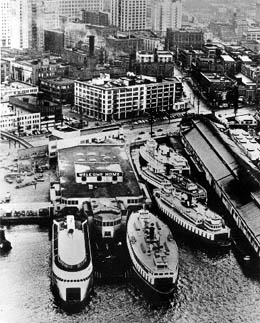On February 29, 1948, Captain Alexander Peabody (1895-1980), president of the Puget Sound Navigation Company (Black Ball Line), ceases operating the ferry system after talks break down with the state government, which refused to grant Peabody's request for a 30 percent increase in rider fares. Stating that he no longer has the money to operate the ferry system, Peabody orders the fleet tied up. For nine days, the state scrambles to provide cross-sound transportation to tens of thousands of commuters, and seriously begins steps to start a state-run ferry system of its own.
Deja vu
A year earlier, a labor disagreement had shut down the ferry system for six days with similar effects. To transport commuters, wartime LSTs (Landing Ship, Tanks) were brought into service, as well as light aircraft, around-the-sound buses, and private boats. At the time, many commuters were upset that the shut-down of one privately-owned company could create such havoc.
This time, commuters' anger intensified against Captain Peabody. It was stirred by his actions over the past 12 months. Firstly, he was requesting higher rates, which were hard to swallow now that the cost of living was rising so much. Secondly, after the state turned down his request, he threatened to shut the ferry system down. Thirdly, he did exactly that.
Civic and community groups had already been lobbying Governor Mon C. Wallgren to step in and create a state-run system to provide competition against what they perceived as a monopoly. Others felt that the state should just buy out the ferry company and run it instead. Wallgren had been stepping delicately along these lines, not wanting to upset those who perceived a state-run ferry system as the wrong solution. Elections were coming up in 1948, and Wallgren was playing close to the chest. But then Peabody's shutdown forced the state's hand.
Punching Out
On February 14, 1948, Peabody read a statement at a meeting of the Washington Toll Bridge Authority, giving them notice that he was shutting down the ferry system through (what he perceived as) no fault of his own. He professed that the state now had responsibility to provide ferry service to its citizenry, and that he'd lease the vessels and facilities to the state for fair compensation, while they reconsidered his request for higher rates.
His offer was rejected. A few days later, a petition signed by 500 Black Ball workers was presented to Governor Wallgren, requesting the 30 percent rate hike, and the sacking of Transportation Director Paul Revelle. Revelle laughed it off, referring to Peabody in the press as a "law violator." Meanwhile everyone braced for the shutdown.
At a public meeting in Bremerton on February 25, 1948, the tension was apparent. State Highways Director Clarence B. Shain explained to those gathered that the state was looking into a makeshift plan to provide ferry service while they decided what to do next. A heckler bombarded him with questions, and Shain threatened to punch him out by telling the heckler that he'd be glad to take this up with him in the alley after the meeting. A pall settled on the proceedings.
On the evening of February 29, 1948, Governor Wallgren and Paul Revelle met with Peabody again in Olympia, with the hopes of coming to a mutual agreement. Peabody refused to compromise and left. Once back in Seattle, he gave the order to tie up the fleet.
Blackballed
The next morning, LSTs, leased boats, planes, and buses navigated in, over, and around the Sound. This provided temporary transportation, but many businesses and individuals were hit hard by the loss of the ferries, especially those who delivered freight. More and more, people began demanding that the state end Peabody's monopoly for good.
Wallgren looked into buying the ferry Hayward from the Moore Dry Dock Company in San Francisco. He also requested proposals from boat builders for the construction of new ferries. All this was well and good, but a fleet of ferries was no good without docking facilities. Peabody owned all the docks.
The state government then looked into condemning all of the dock facilities, but discovered that they had no authority to do this. The docks were covered under agreements with each county, and only county governments could step in, requiring a lot of political wrangling throughout the region. The state then offered to buy some of the docks and most of the fleet from Peabody. Peabody refused.
Troubled Waters
Peabody approached the counties himself, offering them "bare boat charters," lopsided agreements in which the Black Ball Line would receive all of the favorable aspects and the counties would receive all of the liabilities. The counties didn't like it, but given the emergency they were effectively pushed into taking the offers with little compromise. By March 9, 1948, regular services had started once again between King County and Kitsap County. Ferry rates rose by more than 40 percent.
The Black Ball Line was partially back in service, but the handwriting was on the wall. The public was tired of being jerked around and paying high prices, and very few people were complaining if the government wished to start up its own ferry system over which the citizenry had at least some control. Those who didn't like the thought of a government-run ferry system felt that this would only be a short-term fix anyway. Many thought that within the next 10 or so years, a variety of bridges would be built across Puget Sound, negating the need for ferries altogether.
The bridges never came to pass, but the state considered them deeply (and occasionally still do). The ferry issue played heavily in the 1948 gubernatorial race, which Wallgren lost to ex-Governor Arthur Langlie. Both ran on a platform that included a plank for state-run ferries. At this point hardly anyone sided with Captain Peabody, who eventually, in 1951, sold most of his Black Ball Line to the State of Washington.

